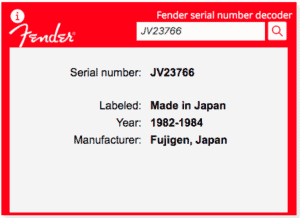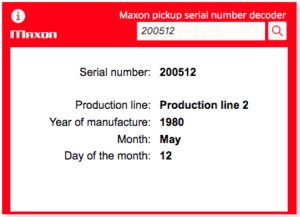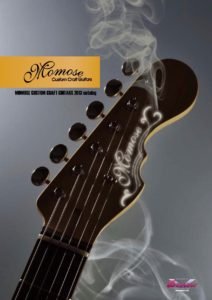First of all, it is worth remembering that Edwards is a subsidiary of ESP which is a renowned Japanese brand whose guitar quality is not to be discussed.
At a certain time, a doubt about the origin of Edwards guitars appeared and was very discussed on the specialized forums. Were these guitars actually made in Japan or in a Joint Venture located in Korea, Vietnam or China?
In the course of my research, I realized that many enthusiasts had tried to obtain information from ESP during the first half of the 2000s, either by contacting distributors or by interviewing exhibitors at international fairs. music, etc. However, ESP did not give any information on the subject or in the best case they remained very evasive … until a day of 2009.
In April 2009, ESP responded by email to a Tokai Forum member about the geographical origin of Edwards guitar production.
Let’s see the answer of ESP on Edwards guitars, in Japanese then in English.
回答させて頂きました。
お手数ですがご確認下さいますようお願い申し上げます。
--お問い合わせ内容--------------------------------------------
edwardsのギターは次のどれですか?
@中国製・日本で部品取り付けなど。
@韓国製・日本で部品取り付けなど。
@ベトナム製・日本で部品取り付けなど。
知らせて下さい。よろしく。吉田。
--回答--------------------------------------------------------
EDWARDSは、木工~塗装までを弊社中国工場(下請けではありません)にて行い、組み込み~セットアップを新東京工場にて行っております。
EDWARDS performs woodworking and painting at our Chinese factory (not a subcontractor), and performs assembly and setup at the new Tokyo factory.
Let’s analyze this data a bit and be objective!
Let’s recall that ESP’s response dates from 2009 and it’s important. We can therefore deduce that at this time at least:
- Finishing, electronics, hardware, plastics and tuners were done / installed in Japan, in the new ESP factory near Tokyo;
- it was not a novelty in itself … it was like that for a while (years?) Even though it is not possible to know exactly how long.
ESP established a Joint-Venture in northeastern China in early 1992, called Heilongjiang ESP Electronic Audio Co., Ltd. (黑龙江 ESP 有限公司 Heilongjiang ESP Electronic Hi-Fi Co. Ltd. Jiguan District, Jixi City, Heilongjiang, China 158100). GRUPO ESP ENTERTAINMENT. This joint-venture has made guitars for ESP.
ESP set up the business at that time thanks to the opening of the “economic sub-region” in North-East China – in short, it was an agreement between China, Russia, Japan and Korea to reduce restrictions and costs on the import and export of finished but mostly unfinished products between these countries. This international cooperation was renewed in 2003.
ESP saw the opportunity to have a cheap and well-trained workforce as well as factories with ample work space for cheap. Of course, for China this meant new jobs in a region that was losing thousands in the industrial and mining sectors. The deal was concluded and ESP set up a factory in Jixi, Heilongjiang, to do all the woodwork and painting of the guitars.
ESP shipped the raw materials by sea to Vladivostok, Russia, and was transported by train for 200 km to the Sino-Russian Commercial Zone of Suifenhe. From there, the materials returned to China, via the port of entry of Suifenhe, and were still transported for 120 km to the factory of ESP in Jixi. When the semi-finished guitars came out of the factory, they were quickly shipped to Japan by land and sea from the Suifenhe customs via Vladivostok or Nakhodka, Russia.
ESP manufacture wasat located at No. 72, Xishan Rd., Jixi, Heilongjiang, China (with a second postal address No. 20 Xishan Rd). It comprised between 120 and 130 employees including 35 engineering technicians, 6 engineers and 2 senior engineers. Taking into account the answer of ESP, the preliminary work on the Edwards guitars was executed in this factory, as well for the part carpentry as for the painting. ESP asserts that a high level of requirement and execution is maintained in Edwards manufacturing as they are produced in their own facilities in China. ESP has indeed its own factory, trained professionals and the production is made under the permanent control of ESP. No production phase is done outside of the brand’s workshops.
During 2009, the factory was relocated not far from there, with brand new facilities, at No. 93 Dongshan Rd, Jiguan District, Jixi City, Heilongjiang, China.
Heilongjiang ESP Electronic Audio Co., Ltd. was ranked 32nd among the 100 largest companies in the electronic music industry in China, according to a document called “Analysis Report of Chinese Competitors in the Electronic Musical Instruments Sector” issued by the Industry Research Report Network. For comparison, Gibson Joint Venture in Qingdao ranked 14th on this list. This classification was based on the following points: business conduct, market shares, growth rate, overall evaluation capacity of competition.
The finishing process and the installation of all electronic components, plastics and accessories were done in Japan at ESP Japan Factory in Saitama, Tokyo. This new factory was inaugurated in June 2008 (see photos at the end of the article). These workshops are located in the Tokyo metropolitan area, 20-30 km north of central Tokyo. ESP also has factories in Sado and Kiso whose productions are mainly for export but they do not produce Edwards instruments.
A good thing for ESP is that the brand does not have gigantic workshops and it only has very well trained and qualified employees. ESP does have Custom Shop in Japan, however, allowing the company to meet the many demands without compromising the quality of its custom instruments. It seems that the Jixi factory in China has followed this same philosophy.
Now, one can of course question the interest that ESP may have in producing the Edwards brand in Northeast China. Of course, there is the question of labor that is cheaper than in Japan, but also the lower cost of facilities and the possibility of relying on employees who can easily be trained. The wages of the Chinese workers are lower than the wages practiced in Korea, at least to this day, and infinitely lower than the wages of the Japanese. Moreover, wages in China are not uniform, far from it. Indeed, a worker in Northeast China earns less than a worker working in a large industrial center such as those found along the coast (Shenzhen, Xangai, Guangzhou and Qingdao).
Some claim that Edwards guitars were again produced 100% in Japan in 2010 or 2011, at least for a certain period. Personally, and this is only the author of this article, I have doubts … Indeed, what would have led ESP to produce his guitars again in Japan? And if so, how could ESP keep its prices? Of course, prices are rising steadily but this is due to the inflation that affects all countries, there has been no significant increase that could demonstrate that the Edwards manufacturing has been relocated to Japan.
Another point that seems important to me is the fact that ESP also produces its guitars Navigator and this subsidiary offers only high-end guitars. In my opinion, and again this is only the author of this article, I do not see why Edwards guitars would compete directly with Navigator guitars that are produced totally in Japan and whose prices are much higher. We can always say that they are two distinct ranges, which would justify the difference in price, but this argument does not convince me.
What are my thoughts on Edwards guitars?
Edwards guitars, originally, were made entirely in Japan, I have little doubt about it. But we know that in 2009 Edwards was manufactured at the ESP plant in Jixi, Heilongjiang, China. I do not know when the production was transferred to China but we can assume that it happened at least a year before ESP’s response by email. But who would put his hand in the fire for ESP? The manufacturing in China could have started well before! In 2007? In 2005? In 2002? Remember that ESP has created its Heilongjiang ESP Electronic Audio Co., Ltd. joint venture in 1992!
A possible return of production of Edwards guitars in Japan is, for me, only speculation. ESP did not say anything about it. There is no reason, therefore, to claim that the Edwards, after 2009, were again, even for a limited period, made in Japan.
But in the end, is it really important? If you are a Made in Japan guitar collector, my answer is yes! Indeed, by buying an Edwards, nothing guarantees that your guitar has been made 100% in Japan. If the guitar was made in 2008 or after, we can be pretty sure that it was made 60-70% in China. If the guitar was made before 2008, the doubt remains …
Now, if you like Japanese brands and the geographical origin of your guitar does not matter to you, then yes, the Edwards will certainly satisfy you because they are excellent guitars. Buying an Edwards is not a bad choice, quite the opposite. Made in China or not, I repeat, these guitars are very good manufacture. The finish is always made in Japan and ESP guarantees the quality of its instruments!
According to ESP representatives, Edwards guitars have the following characteristics:
- Mahogany, Alder and Ash are the wood used.
- Neither Sapele nor African Mahogany are used.
- Mahogany, which is used for the E-LP series, comes from Southeast Asia.
- Edwards LPs all have solid bodies.
Fernandes / Burny was, in my opinion, more transparent and honest in admitting that since 1988 some models have been produced in Taiwan, and that from the 2000s all production was relocated to Korea or China. It’s the same with Greco and many other Japanese brands …
That said, I do not write this article to denigrate the guitars Made in China Japanese brands. Fernandes / Burny and Edwards are guitars of very good quality. As for Fernandes / Burny made in China, we get excellent guitars by changing the electronics and fittings for an interesting price.
Although the Edwards are part of a series whose manufacturing quality remains below the Navigator guitars, their finishes are still well made and they are a wise choice for all guitarists.
Below, images of the ESP Saitama Tokyo factory where the Edwards are in the finishing phase:
Sources: www.tokairegistry.com and www.mylespaul.com













5 Responses
Edwards E-PM-110
Production of 2002-2004, when Seymour Duncan pickups began to put on Edwards guitars.
The inscription “Made in Japan” on the headstock.
https://espguitars.co.jp/edwards_/original/E-JB-110PM.html
It look like 2011 to now are made in japan Edwards here is the proof , that one is a 2013 you can see on the pics it says made in Japan
EDIT: Ads Link removed by admin.
Hello sir…thank you for posting this…
For me this posting is a great information & really really objective…
Greetings from Indonesia.
Can anything be determined by the headstocks and logos?
FYI, Japanese law allows MIJ stickers to be placed on products partially manufactured outside of Japan but assembled in Japan. That’s why you will find MIJ stickers.